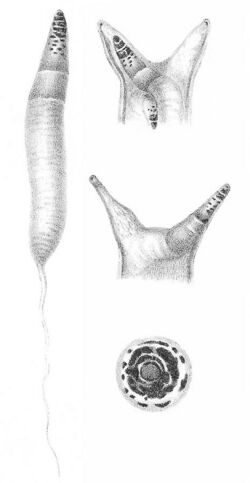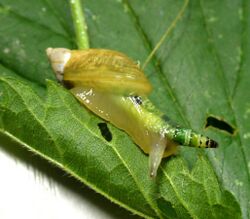Biology:Leucochloridium paradoxum
| Leucochloridium paradoxum | |
|---|---|

| |
| Leucochloridium paradoxum, parasite in Succinea putris | |
| Scientific classification | |
| Domain: | Eukaryota |
| Kingdom: | Animalia |
| Phylum: | Platyhelminthes |
| Class: | Trematoda |
| Order: | Diplostomida |
| Family: | Leucochloridiidae |
| Genus: | Leucochloridium |
| Species: | L. paradoxum
|
| Binomial name | |
| Leucochloridium paradoxum (Carus, 1835)[1]
| |
Leucochloridium paradoxum, the green-banded broodsac, is a parasitic flatworm (or helminth). Its intermediate hosts are land snails, usually of the genus Succinea. The pulsating, green broodsacs fill the eye stalks of the snail, thereby attracting predation by birds, the primary host. These broodsacs visually imitate caterpillars, a prey of birds.[2] The adult parasite lives in the bird's cloaca, releasing its eggs into the faeces.
Life cycle
The species in Leucochloridium share a similar life cycle.[3][4] They are parasites of snails and birds. This is a truncated life cycle compared with typical trematodes, because the snail acts as both the first and second intermediate host.[5]
-
Sporocyst. The stalk of the largest broodsac is drawn shortened. A metacercaria is passing along the lowest stalk.
-
Mature metacercaria ready to be transferred to the bird host; note the thick coat.
-
Adult found in the cloaca of the host bird; note the two prominent suckers.
Eggs ingested by the snail hatch into miracidia, which develop in the snail's hepatopancreas into the next stage, a sporocyst. The mature sporocyst consists of a number of branches spreading through the haemocoel and may make up a fifth or more of the snail's weight.[6] Some of the branches develop into long tubes ending in a swollen broodsac, but these are staggered in their states of development, so that normally only 2 or 3 are mature simultaneously.[7] One or both of the snail's tentacles become occupied by a mature broodsac, which transforms the appearance. The tentacle is swollen and the pulsating, colourful, banded broodsac visible inside mimics the appearance of an insect larva like a caterpillar. This encourages their consumption by the next host, insectivorous birds. Observations in captivity indicated that birds tore the broodsac out of the snail before eating it,[8] so the snail may survive this. Birds may also become infected by eating broodsacs that have spontaneously burst from the tentacle, surviving for an hour whilst they continue to pulsate.[7][9][10]
At their base,[11] the sporocysts produce asexually many tail-less cercariae, which develop directly into metacercariae within the sporocyst, depositing a thick mucoid coat around themselves. The mature metacercariae are oval in shape, 1.2 × 0.8 mm; typically 100–250 such metacercariae accumulate in a broodsac.[11] If the broodsac is eaten by a bird, the metacercariae pass along its alimentary tract, and lodge in the cloaca. Having lost the mucoid coat, they develop into adult distomes, c. 1.5 mm long. This form has two suckers on the ventral side, which anchor it to the cloacal wall, and a smooth dorsal surface. The adults are hermaphroditic and release eggs into the bird's faeces. Some will be eaten by a snail, thus completing the life cycle.[9][10]
In a study in Russia, snails became infected in spring and summer. The resultant sporocysts were producing infective metacercariae in the following spring but then died in late summer.[7] The lifetime of the adult stage in its bird host is believed to be of the order of weeks or months.[12]
Behaviour of the broodsacs and infected snails
The pulsations of the broodsacs typically vary from 40 to 75 times a minute depending on temperature, but they cease in the dark.[6]
The parasite manipulates the snail host's behaviour in a way likely to make it more conspicuous to birds. In one study of Succinea putris hosts, infected snails stayed in better lit places for longer, sat on higher vegetation, and were more mobile. Whereas 53% of infected snails remained fully exposed for the 45 minutes of the observation period, the figure was only 28% for the controls (nearby snails without Leucochloridium broodsacs).[2] Infected snails may survive for at least a year and continue to be able to use the eyes on the ends of their tentacles.[6] Although snails infected by other Leucochloridium species are reported to continue to reproduce,[3] snails infected by L. paradoxum often show a reduction of the sexual organs.[6]
The appearance and behaviour of the sporocysts is a case of aggressive mimicry, where the parasite vaguely resembles the food of the host, thereby gaining the parasite entry into the host's body by being eaten. This is unlike most other cases of aggressive mimicry, in which the mimic eats the duped animal.[13]
Taxonomy
In older literature, L. paradoxum may be referred to as L. macrostomum, derived from Rudolphi's 1803 description of Fasciola macrostoma, which he later (1809) renamed Distomum macrostomum. Zeller (1874) misidentified specimens of L. paradoxum as D. macrostomum. Rudolphi's species is now in the genus Urogonimus.[14] Leucochloridium heckerti Kagan, 1951 is also considered a synonym of L. paradoxum.[9]

Identification
The easiest way to differentiate between Leucochloridium species is from the appearance of the broodsacs in the tentacle of the host snail. Leucochloridium paradoxum exhibits broodsacs that have green bands with dark brown and black spots, and with a dark-brown or reddish-brown tip.[9][6] Nowadays this method of identification may be supported with ribosomal DNA sequences.[12] A snail may be simultaneously infected by more than one species of Leucochloridium.[15]
The adults, found in the cloaca of birds, are less well known, so that distinguishing the species is less straightforward.[12]
Habitat
Leucochlordium paradoxum is found in moist areas, such as marshes, where the usual intermediate host Succinea snails are found.
Distribution

Leucochloridium paradoxum was originally described based on its sporocyst stage, collected from an island in the river Elbe at Pillnitz, near Dresden, Germany.[1] Other known locations are Poland, Belarus, the St Petersburg area of Russia, Denmark, Sweden, Norway, the Netherlands, the United Kingdom and Japan.[12][15][9][16] It is believed to be the species of Leuchochloridium infecting an endemic species of semi-slug on Robinson Crusoe Island in the Pacific, the only record from the Southern Hemisphere.[17]
Hosts
Intermediate hosts:
- Succinea putris[12]
- Succinea lauta[16]
- Omalonyx gayana[17]
Hosts:
- Birds
- Zebra finch (Taeniopygia guttata) – experimental[9]
References
- ↑ 1.0 1.1 Carus, C.G. (1835). "Beobachtung über einen merkwürdigen schöngefärbten Eingeweidewurm, Leucochloridium paradoxum mihi, und dessen parasitische Erzeugung in einer Landschnecke, Succinea amphibia Drap. Helix putris Linn.". Nova Acta Physico-Medica. Academiae Caesareae Leopoldino Carolinae Naturae Curiosorum 17 (2. s., v. 7, pt. 1): 85-100 + Pl. VII. https://azon.e-science.pl/zasoby/beobachtung-uber-einen-merkwurdigen-schongefarbten-eingeweidewurm-leucochloridium-paradoxum-mihi-u,13869/.
- ↑ 2.0 2.1 Wesołowska, W.; Wesołowski, T. (March 2014). "Do Leucochloridium sporocysts manipulate the behaviour of their snail hosts?". Journal of Zoology 292 (3): 151–155. doi:10.1111/jzo.12094.
- ↑ 3.0 3.1 Kagan, I.G. (1951). "Aspects in the life history of Neoleucochloridium problematicum (Magath, 1920) New Comb. and Leucochloridium cyanocittae McIntosh, 1932 (Trematoda:Brachylaemidae)". Transactions of the American Microscopical Society 70: 281-3184. doi:10.2307/3223567.
- ↑ Lewis, P.D. (1974). "Helminths of terrestrial molluscs in Nebraska. II. Life cycle of Leucochloridium variae McIntosh, 1932 (Digenea: Leucochloridiidae)". Journal of Parasitology 60 (2): 251. doi:10.2307/3278459.
- ↑ Poulin, R.; Cribb, T. H. (2002). "Trematode life cycles: short is sweet?". Trends in Parasitology 18 (4): 176–183. doi:10.1016/S1471-4922(02)02262-6.
- ↑ 6.0 6.1 6.2 6.3 6.4 Wesenberg-Lund, C. (1931). "Contributions to the development of the Trematoda Digenea. I. The biology of Leucochloridium paradoxum.". Det Kongelike Danske Videnskakbernes Selskab, Naturvidenskabelig-mathematisk Afdeling 4: 90–142. http://publ.royalacademy.dk/books/378/2600?lang=en.
- ↑ 7.0 7.1 7.2 Tokmakova, A.S.; Ataev, G.L. (2015). "Сезонные изменения в биологии Leucochloridium paradoxum (Trematoda, Leucochlomorphidae)" (in Russian). Parazitologiya 49 (3): 200-207. https://www.zin.ru/journals/parazitologiya/content/2015/prz_2015_3_5_Ataev.pdf.
- ↑ Zeller, E. (1874). "Über Leucochloridium paradoxum Carus und die weitere Entwickung seiner Distomenbrut.". Zeitschrift für wissenschaftliche Zoologie 24: 564–578 + Pl. XLVIII.
- ↑ 9.0 9.1 9.2 9.3 9.4 9.5 Bakke, T. A. (April 1980). "A revision of the family Leucochloridiidae Poche (Digenea) and studies on the morphology of Leucochloridium paradoxum Carus, 1835". Systematic Parasitology 1 (3-4): 189–202. doi:10.1007/BF00009845.
- ↑ 10.0 10.1 Heckert, G.A. (1889). "Leucochloridium paradoxam. Monographische darstellung der entwicklungs- und Lebensgeschichte des Distomum macmstomum". Bibliotheca Zoologica 4: 1-66 + Pls I-IV. https://www.biodiversitylibrary.org/page/12907113.
- ↑ 11.0 11.1 Ataev, G.L.; Dobrovolskij, A.A.; Tokmakova, A.S. (2014). "Размножение партенит трематод Leucochloridium paradoxum (Trematoda: Leucochloridiidae)" (in Russian). Parazitologiya 47 (2): 178-182. https://www.zin.ru/journals/Parazitologiya/content/2013/prz_2013_2_5_Ataev.pdf.
- ↑ 12.0 12.1 12.2 12.3 12.4 Casey, S.P.; Bakke, T.A.; Harris, P.D.; Cable, J. (2003). "Use of ITS rDNA for discrimination of European green- and brown-banded sporocysts within the genus Leucochloridium Carus, 1835 (Digenea: Leucochloriidae)". Systematic Parasitology 56: 163–168. doi:10.1023/B:SYPA.0000003809.15982.ca.
- ↑ Jackson, R. R.; Cross, F. R. (2013). "A cognitive perspective on aggressive mimicry". Journal of Zoology 290 (3): 161–171. doi:10.1111/jzo.12036.
- ↑ Kagan, I.G. (1952). "Revision of the subfamily Leucochloridiinae Poche, 1907 (Trematoda: Brachylaemidae)". American Midland Naturalist 48 (2): 257. doi:10.2307/2422256.
- ↑ 15.0 15.1 Ataev, G. L.; Zhukova, A. A.; Tokmakova, А. S.; Prokhorova, Е. E. (August 2016). "Multiple infection of amber Succinea putris snails with sporocysts of Leucochloridium spp. (Trematoda)". Parasitology Research 115 (8): 3203–3208. doi:10.1007/s00436-016-5082-6.
- ↑ 16.0 16.1 Nakao, Minoru; Sasaki, Mizuki; Waki, Tsukasa; Iwaki, Takashi; Morii, Yuta; Yanagida, Kazumi; Watanabe, Megumi; Tsuchitani, Yoshikazu et al. (October 2019). "Distribution records of three species of Leucochloridium (Trematoda: Leucochloridiidae) in Japan, with comments on their microtaxonomy and ecology". Parasitology International 72: 101936. doi:10.1016/j.parint.2019.101936.
- ↑ 17.0 17.1 Castillo, V.M.; González, H. (2021). "Evidence of parasitism in the semi-slug Omalonyx gayana d’Orbigny, 1835 with Leucochloridium paradoxum (Carus, 1835) sporocysts on Robinson Crusoe Island". Tentacle 29: 34-35. http://www.hawaii.edu/cowielab/Tentacle/Tentacle_29.pdf.
External links
- Distome (Leucochloridium paradoxum), The Living World of Molluscs
Wikidata ☰ Q138713 entry
 |




